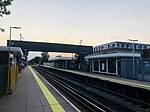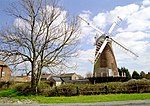Polegate
Civil parishes in East SussexEngvarB from May 2016Towns in East SussexWealden District

Polegate is a town and civil parish in the Wealden District of East Sussex, England, United Kingdom. It is located five miles (8 km) north of the seaside resort of Eastbourne and is part of the greater area of that town. Although once a railway settlement, its rail links were closed as part of the Beeching cuts. The 2011 census put the civil parish of Polegate at a population of 8,586, with 41.2% aged 65 and over.
Excerpt from the Wikipedia article Polegate (License: CC BY-SA 3.0, Authors, Images).Polegate
High Street, Wealden Polegate
Geographical coordinates (GPS) Address Nearby Places Show on map
Geographical coordinates (GPS)
| Latitude | Longitude |
|---|---|
| N 50.8216 ° | E 0.2442 ° |
Address
High Street
High Street
BN26 5EP Wealden, Polegate
England, United Kingdom
Open on Google Maps






